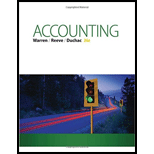
Concept explainers
Capital expenditures budget
On January 1, 2016, the controller of Omicron Inc. is planning capital expenditures for the years 2016-2019. The following interviews helped the controller collect the necessary information for the capital expenditures budget:
Director of Facilities: A construction contract was signed in late 2015 for the construction of a new factory building at a contract cost of $ 10,000,000. The construction is scheduled to begin in 2016 and be completed in 2017.
Vice President of Manufacturing: Once the new factory building is finished, we plan to purchase $ 1 .5 million in equipment in late 2017. I expect that an additional $200,000 will be needed early in the following year (2018) to test and install the equipment before we can begin production. If sales continue to grow, I expect we'll need to invest another $1,000,000 in equipment in 2019.
Chief Operating Officer: We have really been growing lately. I wouldn't be surprised if we need to expand the size of our new factory building in 2019 by at least 35%. Fortunately, we expect inflation to have minimal impact on construction costs over the next four years. Additionally, I would expect the cost of the expansion to be proportional to the size of the expansion.
Director of Information Systems: We need to upgrade our information systems to wireless network technology. It doesn't make sense to do this until after the new factory building is completed and producing product. During 2018, once the factory is up and running, we should equip the whole facility with wireless technology. I think it would cost us $800,000 today to install the technology. However, prices have been dropping by 25% per year, so it should be less expensive at a later date.
Chief Financial Officer: I am excited about our long-term prospects. My only short-term concern is managing our
Use this interview information to prepare a capital expenditures budget for Omicron Inc. for the years 2016-2019.
Want to see the full answer?
Check out a sample textbook solution
Chapter 22 Solutions
ACCOUNTING-W/CENGAGENOWV2 ACCESS
- Crestwood Industries mixes together sugarcane residue and ethanol. After joint manufacturing costs of $3,500 have been incurred, the mixture separates into two products, biomass fuel and industrial alcohol. At the split-off point, biomass fuel can be sold for $6,500, and the alcohol can be sold for $10,500. The biomass fuel can be further processed at a cost of $7,500 to make bio-bricks, which could be sold for $17,500. The alcohol can be further processed at a cost of $8,500 to make a disinfectant, which could be sold for $16,500.What is the net increase (decrease) in operating income from bio-bricks?need answerarrow_forwardAccountingarrow_forwardWant Answerarrow_forward
- Diego Co. records sinking fund transactions currently and maintains a balance in the retained earnings appropriated for sinking fund account equal to the sinking fund. There is no trustee. The following transactions relate to the company's sinking fund set up for the retirement of its long-term bonds payable.1. In accordance with the terms of the bond indenture, cash in the amount of P18,000,000 is transferred at the end of the first year, from the regular cash account to the sinking fund.2. The sinking fund cash is used to acquire Silang Corp.'s 12%, five-year bonds of 5,000,000 at face value.3. The sinking fund cash is used to acquire 10% P50 par value Melchora Inc. 100,000 preference shares at P80 per share.4. Semi-annual interest is received on the Silang bonds.5. Sinking fund expenses of P200,000 are paid from the fund.6. This sinking fund cash is used to acquire Aquino Co. 10% bonds of P4,000,000, maturing in 4 years at face value plus six months accrued interest.7. Half of the…arrow_forwardTOKYO ended the year with an inventory ofarrow_forwardCrestwood Industries mixes together sugarcane residue and ethanol. After joint manufacturing costs of $3,500 have been incurred, the mixture separates into two products, biomass fuel and industrial alcohol. At the split-off point, biomass fuel can be sold for $6,500, and the alcohol can be sold for $10,500. The biomass fuel can be further processed at a cost of $7,500 to make bio-bricks, which could be sold for $17,500. The alcohol can be further processed at a cost of $8,500 to make a disinfectant, which could be sold for $16,500.What is the net increase (decrease) in operating income from bio-bricks? answerarrow_forward
- What is the value of ending inventory?arrow_forwardOn May 10, 2005, Ramirez Company purchased P18,000 worth of merchandise from Valencia Company on account and with the following terms; 1/10, n/30, FOB shipping point. On May 12, 2005, Ramirez paid P360 on the shipment. On May 15, 2005, Ramirez returned P2,000 of merchandise for credit. Final payment was made to Valencia on May 21, 2005. The merchandise was then sold to cash customers for P30,600 on May 24, 2005. Based on the above data, what is the gross profit rate of Ramirez Company? 20% 50% 40% not givenarrow_forwardAccountingarrow_forward
 Managerial AccountingAccountingISBN:9781337912020Author:Carl Warren, Ph.d. Cma William B. TaylerPublisher:South-Western College Pub
Managerial AccountingAccountingISBN:9781337912020Author:Carl Warren, Ph.d. Cma William B. TaylerPublisher:South-Western College Pub Financial And Managerial AccountingAccountingISBN:9781337902663Author:WARREN, Carl S.Publisher:Cengage Learning,
Financial And Managerial AccountingAccountingISBN:9781337902663Author:WARREN, Carl S.Publisher:Cengage Learning, Survey of Accounting (Accounting I)AccountingISBN:9781305961883Author:Carl WarrenPublisher:Cengage Learning
Survey of Accounting (Accounting I)AccountingISBN:9781305961883Author:Carl WarrenPublisher:Cengage Learning- Principles of Accounting Volume 2AccountingISBN:9781947172609Author:OpenStaxPublisher:OpenStax College
 EBK CONTEMPORARY FINANCIAL MANAGEMENTFinanceISBN:9781337514835Author:MOYERPublisher:CENGAGE LEARNING - CONSIGNMENT
EBK CONTEMPORARY FINANCIAL MANAGEMENTFinanceISBN:9781337514835Author:MOYERPublisher:CENGAGE LEARNING - CONSIGNMENT Fundamentals Of Financial Management, Concise Edi...FinanceISBN:9781337902571Author:Eugene F. Brigham, Joel F. HoustonPublisher:Cengage Learning
Fundamentals Of Financial Management, Concise Edi...FinanceISBN:9781337902571Author:Eugene F. Brigham, Joel F. HoustonPublisher:Cengage Learning





